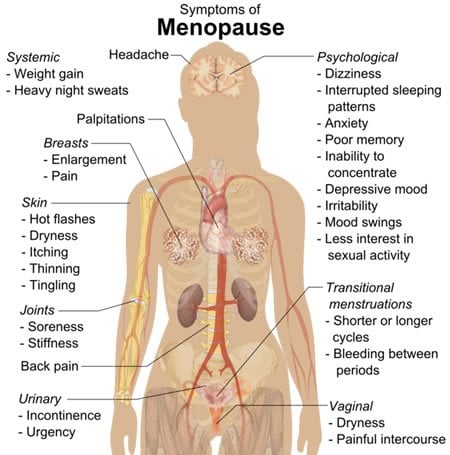If you’re feeling a little blue during the transition to menopause, there’s good reason, according to a new study being reported online today in Menopause. The study from the Department of Psychiatry at the University of North Carolina at Chapel Hill suggests that the estradiol (a form of estrogen) fluctuation that is common during the menopausal transition may enhance emotional sensitivity to psychosocial stress. When combined with a very stressful life event, this sensitivity is likely to contribute to the development of a depressed mood.
It is generally accepted within the medical community that women are at greater risk to suffer from depression than men. Some studies show the risk is twice as great for women vs. men to suffer a major depressive disorder (MDD). It has been previously suggested that the greater risk is largely due to depressive episodes that are tied to reproductive events, such as perinatal depression and premenstrual dysphoric disorder, when hormones are in greater flux. In addition, the menopausal transition and early postmenopausal period are times of particularly increased vulnerability to depression for women, with rates of MDD and clinical elevations in depressive symptoms doubling or even tripling compared to premenopausal and late postmenopausal rates. A substantial proportion of women–between 26% and 33%–will develop clinically significant depressive symptoms within the context of perimenopausal hormonal flux.

The common physiological change occurring during the menopausal transition is extreme variability in estradiol concentrations, thus prompting the 12-month placebo-controlled randomized trial evaluating the mood and cardiovascular benefits of transdermal estradiol in perimenopausal women. The findings from the placebo group found that, in general, estradiol variability led to the development of depressive symptoms, as well as greater anger/irritability and feelings of rejection. More specifically, the findings suggest that perimenopausal estradiol fluctuation may increase women’s sensitivity to social rejection, and when this sensitivity is combined with psycho-social stressors such as divorce or bereavement, women are particularly vulnerable to developing clinically significant depressive symptoms. Of note, however, is that the effect of estradiol variability on mood is not the same in all women and, if a severe life stress did not occur, estradiol variability did not lead to depression. Very severe life stresses were defined and included divorce or separation, serious illness of a close relative or friend, significant current financial issues, physical or sexual abuse or assault, significant arrest of self or loved one.
“These results provide tremendous insight for practitioners. Clinicians need to understand the impact of perimenopausal hormonal fluctuations and the degree of stressful events that a woman is experiencing to determine the best treatment options when a middle-aged woman complains of depression or exaggerated irritability,” says NAMS Executive Director JoAnn Pinkerton, MD, NCMP. “This study provides a foundation for future studies to evaluate the value of psycho-social interventions, such as cognitive therapies, to lessen the effect of major life events, as well as the use of estrogen therapy during perimenopausal and menopausal stressful times.”
Funding: The study was funded by National Institutes of Health, Fonds de la Recherche du Quebec–Sante.
Source: Eileen Petridis – NAMS
Image Source: The image is credited to Mikael Häggström and is in the public domain
Original Research: Abstract for “Estradiol variability, stressful life events, and the emergence of depressive symptomatology during the menopausal transition” by Gordon, Jennifer L.; Rubinow, David R.; Eisenlohr-Moul, Tory A.; Leserman, Jane; and Girdler, Susan S in Menopause. Published online October 21 2015 doi:10.1097/GME.0000000000000528
Abstract
Estradiol variability, stressful life events, and the emergence of depressive symptomatology during the menopausal transition
Objective: The aim of the study was to examine the role of estradiol fluctuation in triggering depressive symptoms in the menopausal transition and assess the role of recent very stressful life events (VSLEs) as a moderating factor in this relationship.
Methods: A total of 52 euthymic women in the menopausal transition or early postmenopause (age 45-60) who were assigned to the placebo arm of a randomized controlled trial of hormone therapy provided the data for this report. At enrollment, women’s experience of recent VSLEs, depressive symptoms, serum estradiol, and progesterone were assessed. At months 1, 8, and 14, depressive symptoms and hormones were reassessed, and participants underwent a stressor battery involving a speech and a mental arithmetic task. Participants rated their feelings of anxiety, fear, anger, and rejection. The standard deviation of estradiol provided an index of hormone variability over the entire 14 months.
Results: Greater estradiol variability across the 14 months predicted greater depressive symptoms at month 14, though only in women reporting a higher number of VSLEs at baseline (39% of women reported <=1 recent event). Greater estradiol variability also predicted greater feelings of rejection to the laboratory stressor at months 8 and 14. Furthermore, among women reporting higher VSLEs at baseline, feelings of rejection in response to the laboratory stressor at month 8 predicted depressive symptoms at month 14.
Conclusions: These data suggest that estradiol variability may enhance emotional sensitivity to psychosocial stress, particularly sensitivity to social rejection. Combined with VSLEs proximate to the menopausal transition, this increased sensitivity may contribute to the development of depressed mood.
“Estradiol variability, stressful life events, and the emergence of depressive symptomatology during the menopausal transition” by Gordon, Jennifer L.; Rubinow, David R.; Eisenlohr-Moul, Tory A.; Leserman, Jane; and Girdler, Susan S in Menopause. Published online October 21 2015 doi:10.1097/GME.0000000000000528






